Qualitative Research Analysis: Smith et al. Obesity Study Report
VerifiedAdded on 2020/03/01
|7
|1562
|201
Report
AI Summary
This report critically appraises the qualitative research conducted by Smith et al. (2014) on obese adolescents' experiences with text messaging for behavior change maintenance post-intervention, framed by the criteria outlined by Popay et al. (1998). The analysis examines subjective meaning, research context, participant selection, interpretation of participant accounts, the use of 'lay' knowledge, researcher flexibility, and the generalizability of findings. The study involved focus groups with overweight adolescents and their parents, exploring their perceptions of text messages used after a healthy lifestyle program. The report highlights the study's strengths, such as participant validation through parental corroboration, and its limitations, including potential issues with generalizability due to the sample's situational representativeness. The report concludes by emphasizing the study's contribution to understanding the effectiveness of text messaging in supporting adolescent behavior change and its implications for future research and policy development in the healthcare sector, particularly in pediatric weight management programs.
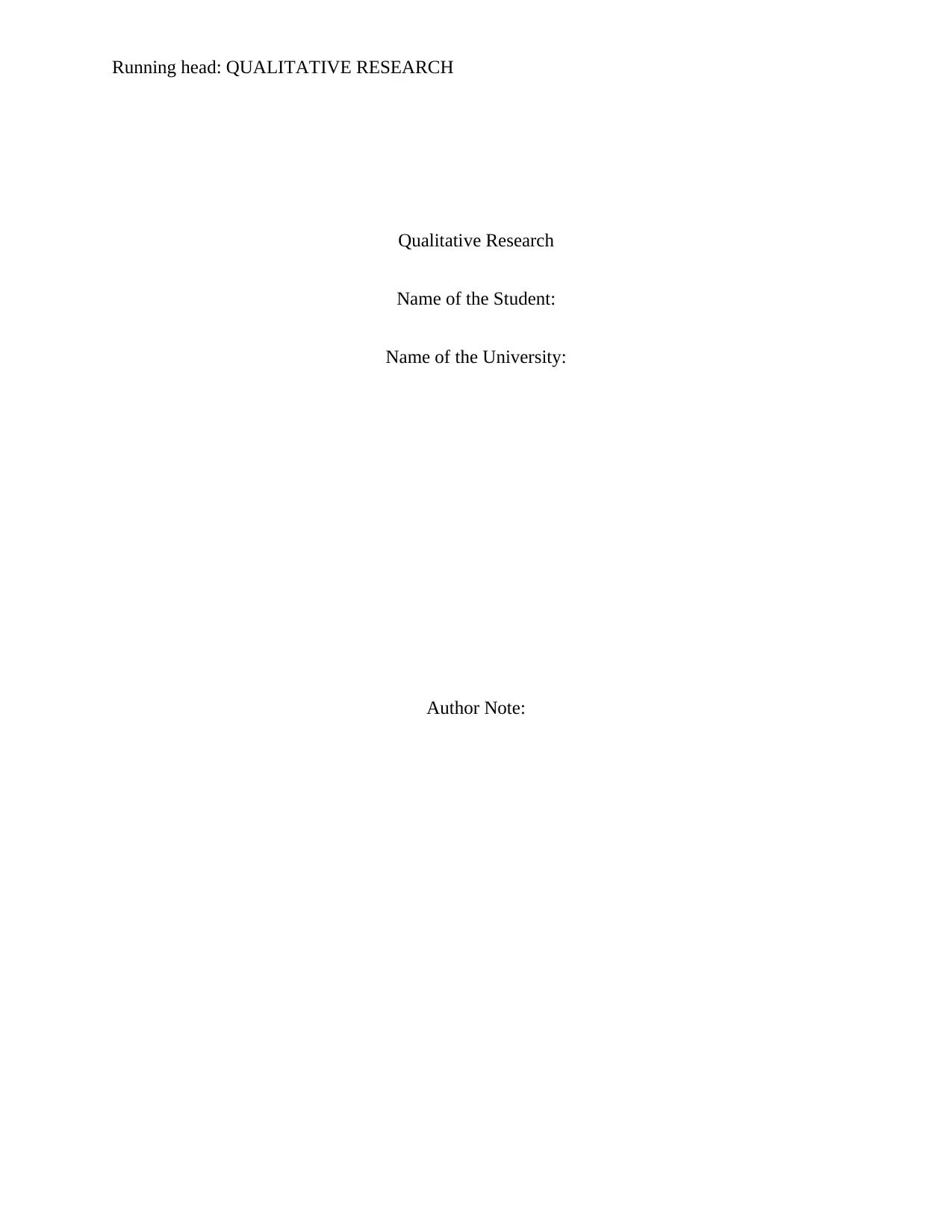
Running head: QUALITATIVE RESEARCH
Qualitative Research
Name of the Student:
Name of the University:
Author Note:
Qualitative Research
Name of the Student:
Name of the University:
Author Note:
Paraphrase This Document
Need a fresh take? Get an instant paraphrase of this document with our AI Paraphraser
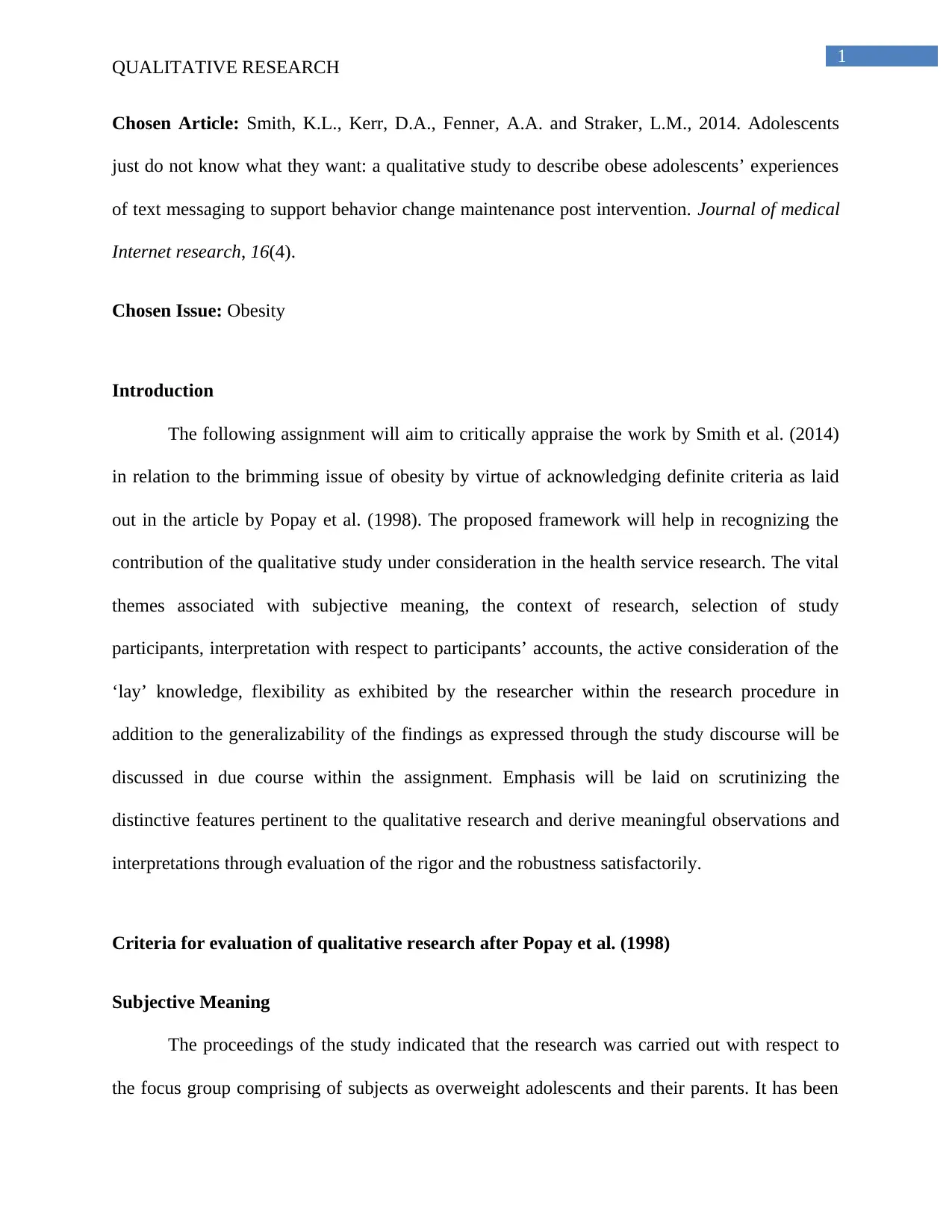
1
QUALITATIVE RESEARCH
Chosen Article: Smith, K.L., Kerr, D.A., Fenner, A.A. and Straker, L.M., 2014. Adolescents
just do not know what they want: a qualitative study to describe obese adolescents’ experiences
of text messaging to support behavior change maintenance post intervention. Journal of medical
Internet research, 16(4).
Chosen Issue: Obesity
Introduction
The following assignment will aim to critically appraise the work by Smith et al. (2014)
in relation to the brimming issue of obesity by virtue of acknowledging definite criteria as laid
out in the article by Popay et al. (1998). The proposed framework will help in recognizing the
contribution of the qualitative study under consideration in the health service research. The vital
themes associated with subjective meaning, the context of research, selection of study
participants, interpretation with respect to participants’ accounts, the active consideration of the
‘lay’ knowledge, flexibility as exhibited by the researcher within the research procedure in
addition to the generalizability of the findings as expressed through the study discourse will be
discussed in due course within the assignment. Emphasis will be laid on scrutinizing the
distinctive features pertinent to the qualitative research and derive meaningful observations and
interpretations through evaluation of the rigor and the robustness satisfactorily.
Criteria for evaluation of qualitative research after Popay et al. (1998)
Subjective Meaning
The proceedings of the study indicated that the research was carried out with respect to
the focus group comprising of subjects as overweight adolescents and their parents. It has been
QUALITATIVE RESEARCH
Chosen Article: Smith, K.L., Kerr, D.A., Fenner, A.A. and Straker, L.M., 2014. Adolescents
just do not know what they want: a qualitative study to describe obese adolescents’ experiences
of text messaging to support behavior change maintenance post intervention. Journal of medical
Internet research, 16(4).
Chosen Issue: Obesity
Introduction
The following assignment will aim to critically appraise the work by Smith et al. (2014)
in relation to the brimming issue of obesity by virtue of acknowledging definite criteria as laid
out in the article by Popay et al. (1998). The proposed framework will help in recognizing the
contribution of the qualitative study under consideration in the health service research. The vital
themes associated with subjective meaning, the context of research, selection of study
participants, interpretation with respect to participants’ accounts, the active consideration of the
‘lay’ knowledge, flexibility as exhibited by the researcher within the research procedure in
addition to the generalizability of the findings as expressed through the study discourse will be
discussed in due course within the assignment. Emphasis will be laid on scrutinizing the
distinctive features pertinent to the qualitative research and derive meaningful observations and
interpretations through evaluation of the rigor and the robustness satisfactorily.
Criteria for evaluation of qualitative research after Popay et al. (1998)
Subjective Meaning
The proceedings of the study indicated that the research was carried out with respect to
the focus group comprising of subjects as overweight adolescents and their parents. It has been
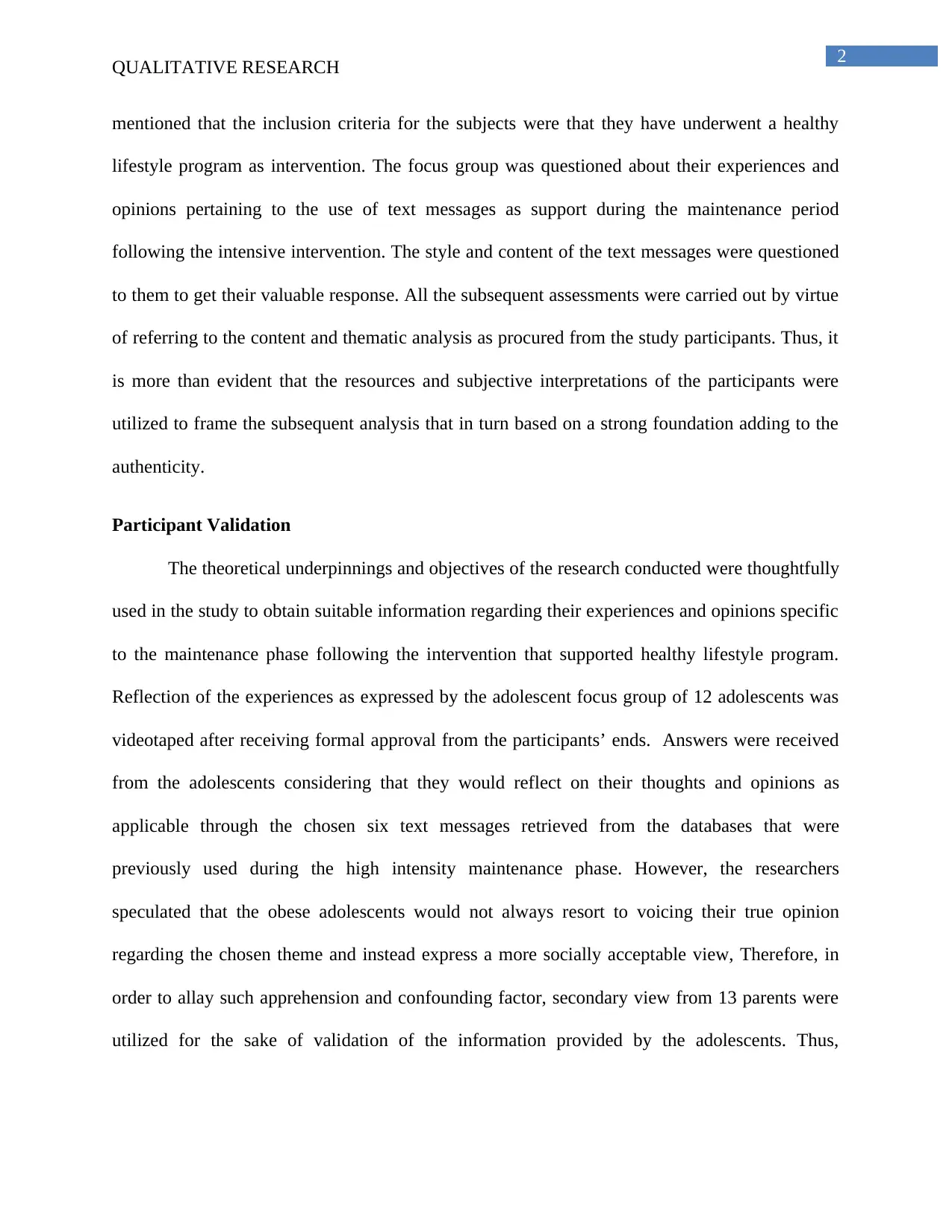
2
QUALITATIVE RESEARCH
mentioned that the inclusion criteria for the subjects were that they have underwent a healthy
lifestyle program as intervention. The focus group was questioned about their experiences and
opinions pertaining to the use of text messages as support during the maintenance period
following the intensive intervention. The style and content of the text messages were questioned
to them to get their valuable response. All the subsequent assessments were carried out by virtue
of referring to the content and thematic analysis as procured from the study participants. Thus, it
is more than evident that the resources and subjective interpretations of the participants were
utilized to frame the subsequent analysis that in turn based on a strong foundation adding to the
authenticity.
Participant Validation
The theoretical underpinnings and objectives of the research conducted were thoughtfully
used in the study to obtain suitable information regarding their experiences and opinions specific
to the maintenance phase following the intervention that supported healthy lifestyle program.
Reflection of the experiences as expressed by the adolescent focus group of 12 adolescents was
videotaped after receiving formal approval from the participants’ ends. Answers were received
from the adolescents considering that they would reflect on their thoughts and opinions as
applicable through the chosen six text messages retrieved from the databases that were
previously used during the high intensity maintenance phase. However, the researchers
speculated that the obese adolescents would not always resort to voicing their true opinion
regarding the chosen theme and instead express a more socially acceptable view, Therefore, in
order to allay such apprehension and confounding factor, secondary view from 13 parents were
utilized for the sake of validation of the information provided by the adolescents. Thus,
QUALITATIVE RESEARCH
mentioned that the inclusion criteria for the subjects were that they have underwent a healthy
lifestyle program as intervention. The focus group was questioned about their experiences and
opinions pertaining to the use of text messages as support during the maintenance period
following the intensive intervention. The style and content of the text messages were questioned
to them to get their valuable response. All the subsequent assessments were carried out by virtue
of referring to the content and thematic analysis as procured from the study participants. Thus, it
is more than evident that the resources and subjective interpretations of the participants were
utilized to frame the subsequent analysis that in turn based on a strong foundation adding to the
authenticity.
Participant Validation
The theoretical underpinnings and objectives of the research conducted were thoughtfully
used in the study to obtain suitable information regarding their experiences and opinions specific
to the maintenance phase following the intervention that supported healthy lifestyle program.
Reflection of the experiences as expressed by the adolescent focus group of 12 adolescents was
videotaped after receiving formal approval from the participants’ ends. Answers were received
from the adolescents considering that they would reflect on their thoughts and opinions as
applicable through the chosen six text messages retrieved from the databases that were
previously used during the high intensity maintenance phase. However, the researchers
speculated that the obese adolescents would not always resort to voicing their true opinion
regarding the chosen theme and instead express a more socially acceptable view, Therefore, in
order to allay such apprehension and confounding factor, secondary view from 13 parents were
utilized for the sake of validation of the information provided by the adolescents. Thus,
⊘ This is a preview!⊘
Do you want full access?
Subscribe today to unlock all pages.

Trusted by 1+ million students worldwide
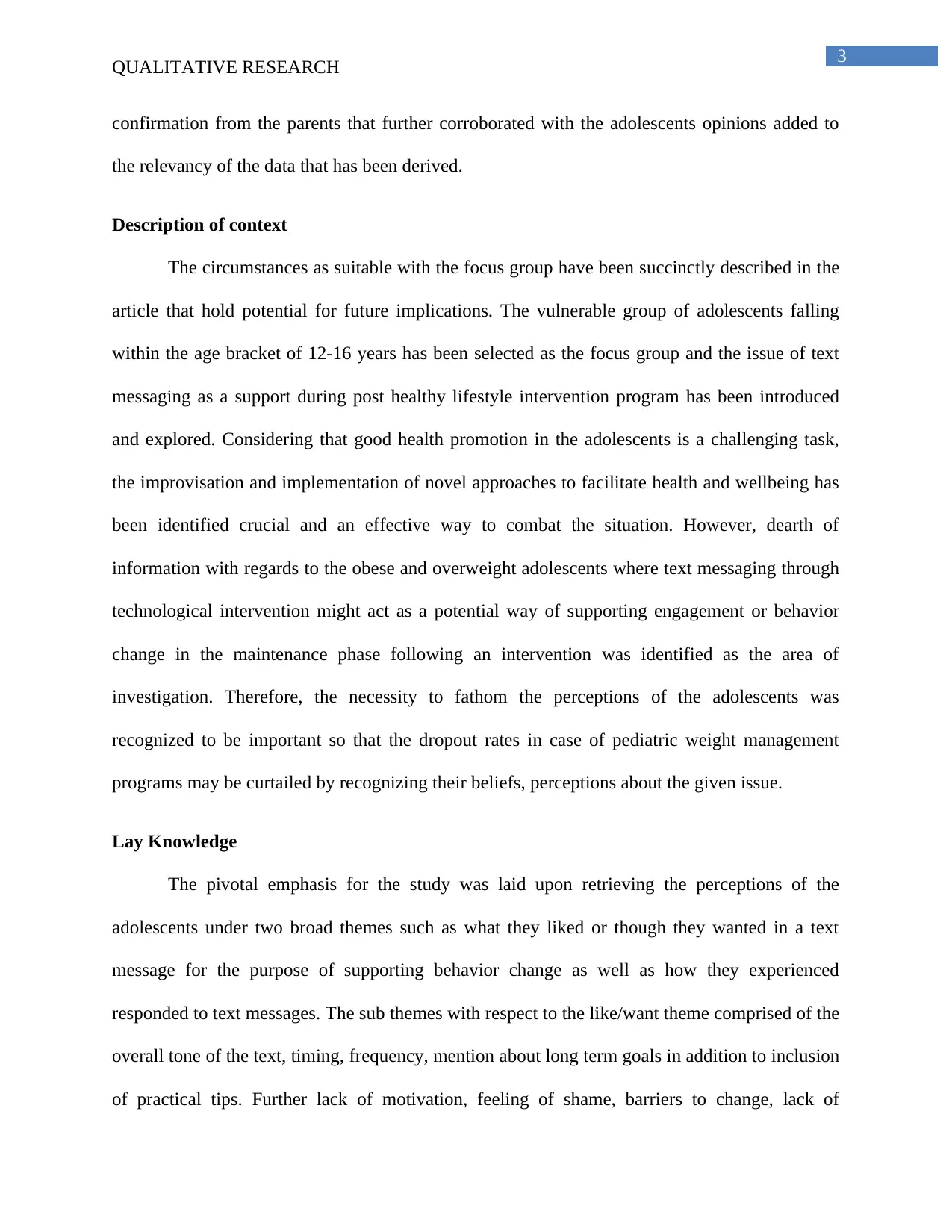
3
QUALITATIVE RESEARCH
confirmation from the parents that further corroborated with the adolescents opinions added to
the relevancy of the data that has been derived.
Description of context
The circumstances as suitable with the focus group have been succinctly described in the
article that hold potential for future implications. The vulnerable group of adolescents falling
within the age bracket of 12-16 years has been selected as the focus group and the issue of text
messaging as a support during post healthy lifestyle intervention program has been introduced
and explored. Considering that good health promotion in the adolescents is a challenging task,
the improvisation and implementation of novel approaches to facilitate health and wellbeing has
been identified crucial and an effective way to combat the situation. However, dearth of
information with regards to the obese and overweight adolescents where text messaging through
technological intervention might act as a potential way of supporting engagement or behavior
change in the maintenance phase following an intervention was identified as the area of
investigation. Therefore, the necessity to fathom the perceptions of the adolescents was
recognized to be important so that the dropout rates in case of pediatric weight management
programs may be curtailed by recognizing their beliefs, perceptions about the given issue.
Lay Knowledge
The pivotal emphasis for the study was laid upon retrieving the perceptions of the
adolescents under two broad themes such as what they liked or though they wanted in a text
message for the purpose of supporting behavior change as well as how they experienced
responded to text messages. The sub themes with respect to the like/want theme comprised of the
overall tone of the text, timing, frequency, mention about long term goals in addition to inclusion
of practical tips. Further lack of motivation, feeling of shame, barriers to change, lack of
QUALITATIVE RESEARCH
confirmation from the parents that further corroborated with the adolescents opinions added to
the relevancy of the data that has been derived.
Description of context
The circumstances as suitable with the focus group have been succinctly described in the
article that hold potential for future implications. The vulnerable group of adolescents falling
within the age bracket of 12-16 years has been selected as the focus group and the issue of text
messaging as a support during post healthy lifestyle intervention program has been introduced
and explored. Considering that good health promotion in the adolescents is a challenging task,
the improvisation and implementation of novel approaches to facilitate health and wellbeing has
been identified crucial and an effective way to combat the situation. However, dearth of
information with regards to the obese and overweight adolescents where text messaging through
technological intervention might act as a potential way of supporting engagement or behavior
change in the maintenance phase following an intervention was identified as the area of
investigation. Therefore, the necessity to fathom the perceptions of the adolescents was
recognized to be important so that the dropout rates in case of pediatric weight management
programs may be curtailed by recognizing their beliefs, perceptions about the given issue.
Lay Knowledge
The pivotal emphasis for the study was laid upon retrieving the perceptions of the
adolescents under two broad themes such as what they liked or though they wanted in a text
message for the purpose of supporting behavior change as well as how they experienced
responded to text messages. The sub themes with respect to the like/want theme comprised of the
overall tone of the text, timing, frequency, mention about long term goals in addition to inclusion
of practical tips. Further lack of motivation, feeling of shame, barriers to change, lack of
Paraphrase This Document
Need a fresh take? Get an instant paraphrase of this document with our AI Paraphraser
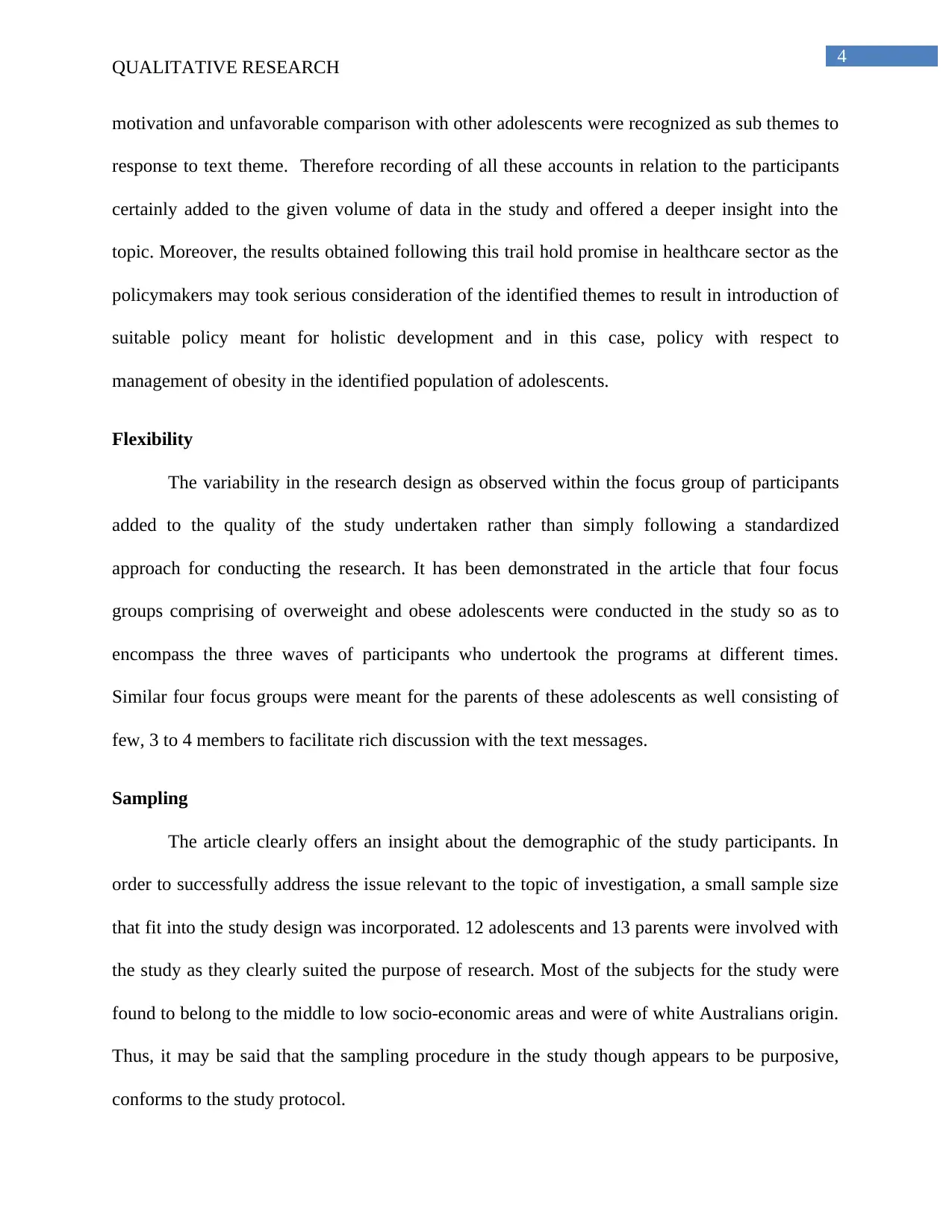
4
QUALITATIVE RESEARCH
motivation and unfavorable comparison with other adolescents were recognized as sub themes to
response to text theme. Therefore recording of all these accounts in relation to the participants
certainly added to the given volume of data in the study and offered a deeper insight into the
topic. Moreover, the results obtained following this trail hold promise in healthcare sector as the
policymakers may took serious consideration of the identified themes to result in introduction of
suitable policy meant for holistic development and in this case, policy with respect to
management of obesity in the identified population of adolescents.
Flexibility
The variability in the research design as observed within the focus group of participants
added to the quality of the study undertaken rather than simply following a standardized
approach for conducting the research. It has been demonstrated in the article that four focus
groups comprising of overweight and obese adolescents were conducted in the study so as to
encompass the three waves of participants who undertook the programs at different times.
Similar four focus groups were meant for the parents of these adolescents as well consisting of
few, 3 to 4 members to facilitate rich discussion with the text messages.
Sampling
The article clearly offers an insight about the demographic of the study participants. In
order to successfully address the issue relevant to the topic of investigation, a small sample size
that fit into the study design was incorporated. 12 adolescents and 13 parents were involved with
the study as they clearly suited the purpose of research. Most of the subjects for the study were
found to belong to the middle to low socio-economic areas and were of white Australians origin.
Thus, it may be said that the sampling procedure in the study though appears to be purposive,
conforms to the study protocol.
QUALITATIVE RESEARCH
motivation and unfavorable comparison with other adolescents were recognized as sub themes to
response to text theme. Therefore recording of all these accounts in relation to the participants
certainly added to the given volume of data in the study and offered a deeper insight into the
topic. Moreover, the results obtained following this trail hold promise in healthcare sector as the
policymakers may took serious consideration of the identified themes to result in introduction of
suitable policy meant for holistic development and in this case, policy with respect to
management of obesity in the identified population of adolescents.
Flexibility
The variability in the research design as observed within the focus group of participants
added to the quality of the study undertaken rather than simply following a standardized
approach for conducting the research. It has been demonstrated in the article that four focus
groups comprising of overweight and obese adolescents were conducted in the study so as to
encompass the three waves of participants who undertook the programs at different times.
Similar four focus groups were meant for the parents of these adolescents as well consisting of
few, 3 to 4 members to facilitate rich discussion with the text messages.
Sampling
The article clearly offers an insight about the demographic of the study participants. In
order to successfully address the issue relevant to the topic of investigation, a small sample size
that fit into the study design was incorporated. 12 adolescents and 13 parents were involved with
the study as they clearly suited the purpose of research. Most of the subjects for the study were
found to belong to the middle to low socio-economic areas and were of white Australians origin.
Thus, it may be said that the sampling procedure in the study though appears to be purposive,
conforms to the study protocol.
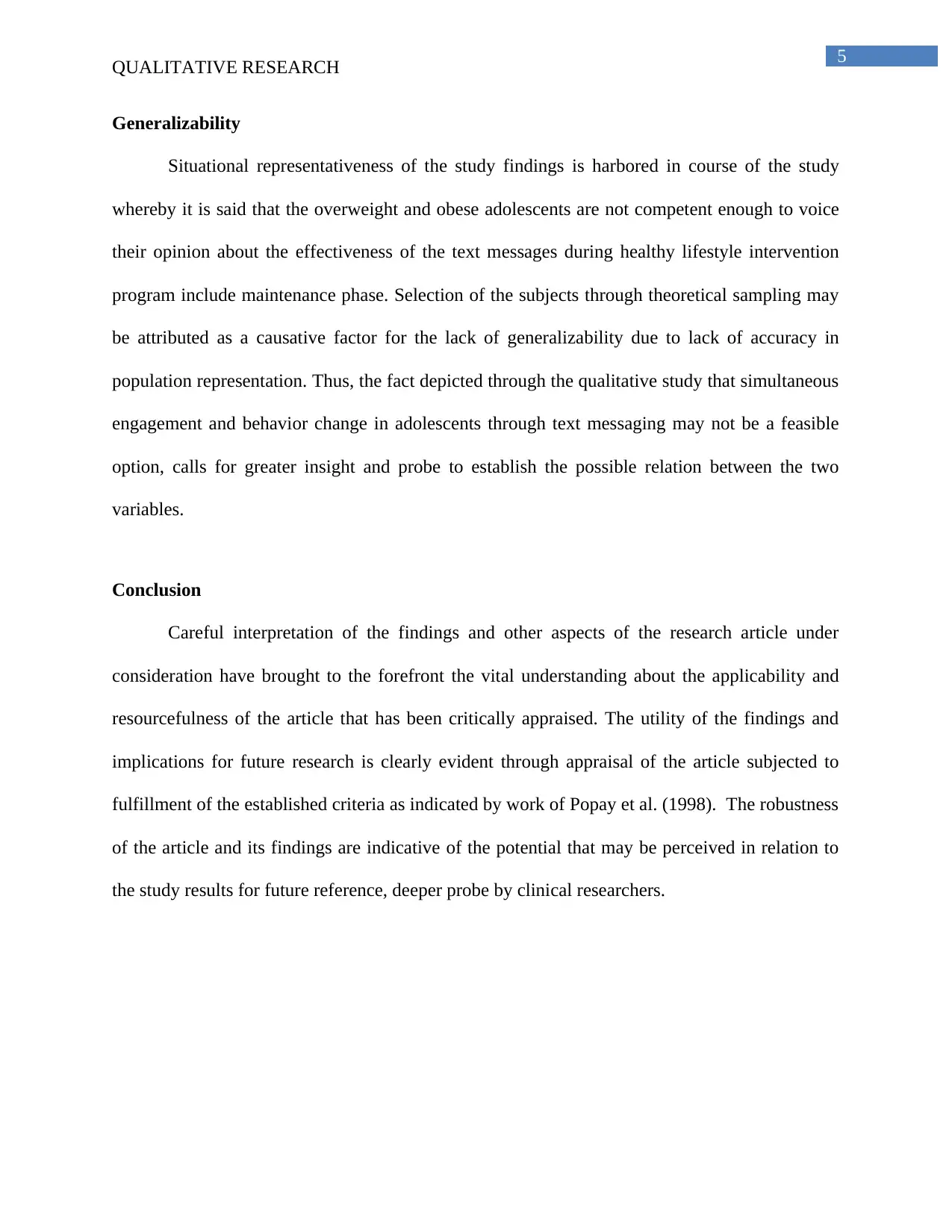
5
QUALITATIVE RESEARCH
Generalizability
Situational representativeness of the study findings is harbored in course of the study
whereby it is said that the overweight and obese adolescents are not competent enough to voice
their opinion about the effectiveness of the text messages during healthy lifestyle intervention
program include maintenance phase. Selection of the subjects through theoretical sampling may
be attributed as a causative factor for the lack of generalizability due to lack of accuracy in
population representation. Thus, the fact depicted through the qualitative study that simultaneous
engagement and behavior change in adolescents through text messaging may not be a feasible
option, calls for greater insight and probe to establish the possible relation between the two
variables.
Conclusion
Careful interpretation of the findings and other aspects of the research article under
consideration have brought to the forefront the vital understanding about the applicability and
resourcefulness of the article that has been critically appraised. The utility of the findings and
implications for future research is clearly evident through appraisal of the article subjected to
fulfillment of the established criteria as indicated by work of Popay et al. (1998). The robustness
of the article and its findings are indicative of the potential that may be perceived in relation to
the study results for future reference, deeper probe by clinical researchers.
QUALITATIVE RESEARCH
Generalizability
Situational representativeness of the study findings is harbored in course of the study
whereby it is said that the overweight and obese adolescents are not competent enough to voice
their opinion about the effectiveness of the text messages during healthy lifestyle intervention
program include maintenance phase. Selection of the subjects through theoretical sampling may
be attributed as a causative factor for the lack of generalizability due to lack of accuracy in
population representation. Thus, the fact depicted through the qualitative study that simultaneous
engagement and behavior change in adolescents through text messaging may not be a feasible
option, calls for greater insight and probe to establish the possible relation between the two
variables.
Conclusion
Careful interpretation of the findings and other aspects of the research article under
consideration have brought to the forefront the vital understanding about the applicability and
resourcefulness of the article that has been critically appraised. The utility of the findings and
implications for future research is clearly evident through appraisal of the article subjected to
fulfillment of the established criteria as indicated by work of Popay et al. (1998). The robustness
of the article and its findings are indicative of the potential that may be perceived in relation to
the study results for future reference, deeper probe by clinical researchers.
⊘ This is a preview!⊘
Do you want full access?
Subscribe today to unlock all pages.

Trusted by 1+ million students worldwide
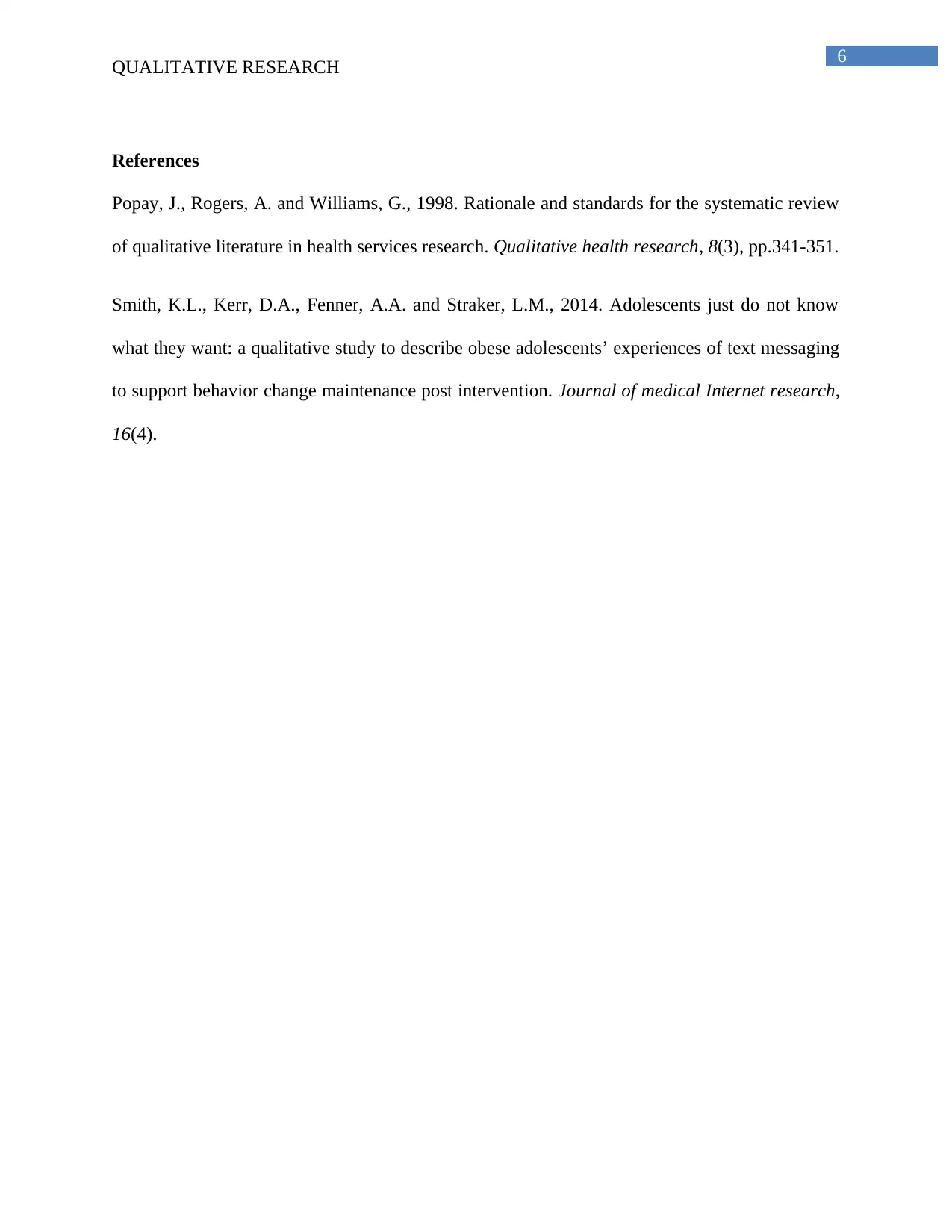
6
QUALITATIVE RESEARCH
References
Popay, J., Rogers, A. and Williams, G., 1998. Rationale and standards for the systematic review
of qualitative literature in health services research. Qualitative health research, 8(3), pp.341-351.
Smith, K.L., Kerr, D.A., Fenner, A.A. and Straker, L.M., 2014. Adolescents just do not know
what they want: a qualitative study to describe obese adolescents’ experiences of text messaging
to support behavior change maintenance post intervention. Journal of medical Internet research,
16(4).
QUALITATIVE RESEARCH
References
Popay, J., Rogers, A. and Williams, G., 1998. Rationale and standards for the systematic review
of qualitative literature in health services research. Qualitative health research, 8(3), pp.341-351.
Smith, K.L., Kerr, D.A., Fenner, A.A. and Straker, L.M., 2014. Adolescents just do not know
what they want: a qualitative study to describe obese adolescents’ experiences of text messaging
to support behavior change maintenance post intervention. Journal of medical Internet research,
16(4).
1 out of 7
Your All-in-One AI-Powered Toolkit for Academic Success.
+13062052269
info@desklib.com
Available 24*7 on WhatsApp / Email
![[object Object]](/_next/static/media/star-bottom.7253800d.svg)
Unlock your academic potential
Copyright © 2020–2025 A2Z Services. All Rights Reserved. Developed and managed by ZUCOL.
